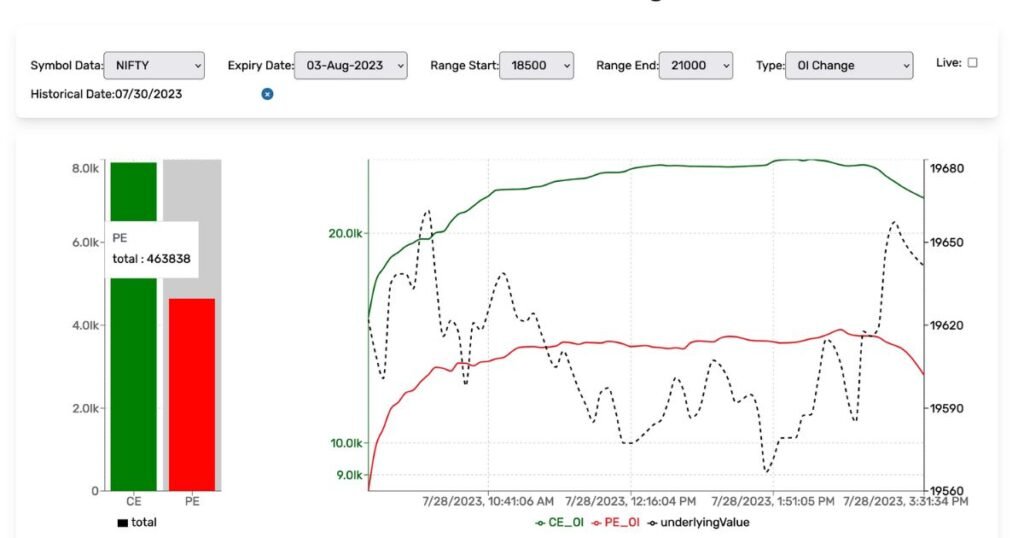Options trading is a dynamic and multifaceted component of the financial markets, offering traders a versatile instrument for speculation and hedging. One critical metric that traders frequently analyze is open interest. Understanding open interest, particularly in Call vs Put Oi options, can provide profound insights into market sentiment and potential price movements.
Open interest represents the total number of outstanding option contracts that are held by market participants at the end of the trading day. Unlike trading volume, which counts the number of contracts traded in a given period, open interest provides a snapshot of market activity and trader positions. This article aims to delve deeply into the concept of Call vs Put Oi , exploring its definitions, implications, and applications in options trading.
Options Trading Basics
Options are financial derivatives that provide the buyer with the right, but not the obligation, to buy or sell an underlying asset at a predetermined price within a specified timeframe. They are widely used in various trading strategies due to their versatility and potential for high returns.
Call Options Explained
A call option grants the holder the right to purchase the underlying asset at a specific price, known as the strike price, before or on the option’s expiration date. Investors typically buy call options when they anticipate that the price of the underlying asset will rise.
Put Options Explained
Conversely, a put option gives the holder the right to sell the underlying asset at the strike price before or on the expiration date. Put options are generally purchased by investors who expect a decline in the price of the underlying asset.
Differences Between Calls and Puts Oi

The primary difference between call and put options lies in their directional use. Calls are used for bullish strategies, while puts are used for bearish strategies. Understanding these fundamental differences is crucial for traders when developing their trading strategies.
Open Interest: Definition and Importance
What is Open Interest?
Open interest is the total number of outstanding option contracts (calls or puts) that have not been settled. It reflects the number of active positions in the market and provides insights into the strength of a particular trend.
How is Open Interest Different from Volume?
While volume measures the number of contracts traded within a specific period, open interest tracks the number of outstanding contracts at the end of the trading day. Volume can fluctuate throughout the trading session, whereas open interest offers a cumulative picture of market activity.
Importance of Open Interest in Options Trading
Open interest is a vital indicator for traders as it helps gauge the liquidity and activity level in a specific options market. High open interest suggests active trading and can indicate potential price movements.
Role of Open Interest in Liquidity
Liquidity is crucial in options trading as it ensures traders can enter and exit positions with minimal price impact. High open interest typically correlates with higher liquidity, making it easier for traders to execute large orders without significantly affecting the market price.
Call Open Interest
Call open interest refers to the total number of outstanding call option contracts that are yet to be settled. It provides insights into the bullish sentiment in the market.
How to Interpret Call Open Interest
High call open interest can indicate strong bullish sentiment, as many traders are betting on the price of the underlying asset rising. However, it is essential to consider this data in conjunction with other indicators and market conditions.
Factors Influencing Call Open Interest
Several factors can influence call open interest, including market sentiment, economic data releases, corporate earnings reports, and broader market trends. For instance, positive news about a company can lead to an increase in call open interest as traders anticipate a rise in the stock price.
Examples of Call Open Interest Analysis
Consider a scenario where a company’s stock has been steadily rising. If the call open interest for options with a strike price near the current market price increases significantly, it can signal that traders expect the upward trend to continue.
How to Interpret Put Open Interest

High put open interest can indicate strong bearish sentiment, as many traders are expecting the price of the underlying asset to fall. Like call open interest, it should be analyzed in the context of other market factors.
Factors Influencing Put Open Interest
Economic downturns, negative corporate news, or broader market declines can lead to an increase in put open interest. For example, if a company’s earnings report is worse than expected, traders might buy put options in anticipation of a decline in the stock price.
Examples of Put Open Interest Analysis
Suppose a major economic report predicts a downturn in a specific sector. In this case, if put open interest in related stocks increases significantly, it could indicate that traders are positioning for potential declines.
Call vs Put Open Interest
Comparing Call and Put Open Interest
Comparing call and put open interest can provide insights into overall market sentiment. A higher call open interest relative to put open interest suggests bullish sentiment, while the opposite indicates bearish sentiment.
What Does High Call vs Put Oi Indicate?
When call open interest significantly exceeds put open interest, it suggests that more traders are betting on the price rising. Conversely, if put open interest is higher, it indicates a bearish outlook.
How Traders Use Call and Put Open Interest Data
Traders use the comparison of call and put open interest to gauge market sentiment and make informed trading decisions. This data can also help identify potential support and resistance levels based on the concentration of open interest at different strike prices.
Historical Trends and Patterns
Analyzing historical trends in call and put open interest can reveal patterns that may predict future price movements. For example, consistent increases in call open interest during a market uptrend can signal sustained bullish sentiment.
Impact of Open Interest on Market Sentiment
Understanding Market Sentiment Through Open Interest
Open interest provides a window into market sentiment, offering clues about whether traders are bullish or bearish. By analyzing changes in open interest, traders can infer the strength of a trend and potential reversals.
How Open Interest Affects Price Movements
High open interest in call options can drive up the price of the underlying asset as traders buy the asset to hedge their positions. Similarly, high put open interest can put downward pressure on the price as traders sell the asset for the same reason.
Case Studies of Open Interest Impact on Market Sentiment
Examining specific case studies where open interest significantly influenced market sentiment can illustrate its practical applications. For example, during earnings season, a spike in open interest for a company’s options can indicate expectations of volatile price movements.
Conclusion
In options trading, understanding the nuances of open interest is essential for making informed trading decisions. Call vs Put Oi interest provide critical insights into market sentiment, helping traders anticipate potential price movements and identify opportunities for profit. By analyzing these metrics alongside other indicators, traders can develop robust strategies that leverage market dynamics effectively.
